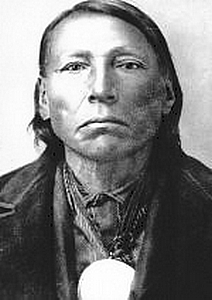Etokeah
Chief Hump
Minniconjou Lakota
(ca. 1848-1908)
Etokeah, a Minniconjou Lakota war chief, known to the whites as Chief Hump, was a great leader. He is especially known for his skills during the 19th Century Lakota-US Government battles. His exact birth date and facts of parentage were not recorded. However, he first came into public notice in 1866. Then, he led the charge against Captain William Fetterman’s soldiers outside Fort Phil Kearney in Wyoming.
 Chief Hump did not sign the Treaty of Fort Laramie in 1866. Because of his action, he was deemed a hostile or “non-treaty” chief by the US Government. He was a comrade-in-arms of Crazy Horse, Red Cloud and other great Sioux chiefs of the period. In 1876, he led his warriors into battle against Generals George Crook and George Custer.
Chief Hump did not sign the Treaty of Fort Laramie in 1866. Because of his action, he was deemed a hostile or “non-treaty” chief by the US Government. He was a comrade-in-arms of Crazy Horse, Red Cloud and other great Sioux chiefs of the period. In 1876, he led his warriors into battle against Generals George Crook and George Custer.
Although very little is known about Hump’s early life, he eventually rose to become a Chief among the Miniconjou Sioux and was an active participant in the Red Cloud war.
With Crazy Horse at the Rosebud Battle against George Crook, Hump led his Miniconjou Sioux, helping stop the column in their trek to meet Custer prior to the Little Big Horn.
At the Little Big Horn, when the alarm was sounded, Hump jumped onto an unknown mount, which threw him to the ground. Hump rushed, mounted another horse and charged toward the soldiers. His horse was shot from under him when a bullet entered above the horse’s knee and went further into Hump’s hip. Hump was stranded there due to the wound and did not participate in the main battle.
Later, Hump went to Canada, and eventually his band returned to the United States, the last of all the bands to return. In company with most of the Sioux, his band was intrigued by the Ghost Dance religion, which culminated in the massacre at Wounded Knee Creek in 1890.
Although Hump seems never to have become a true believer, he did lead his people in the Ghost Dance raids until early December of 1890. The US Army was alarmed by the Ghost Dance, and they sent emissaries to all of the major chiefs.
Captain Ezra Ewers – an old friend – was sent to speak with Hump. Ewers convinced Hump of the futility in armed resistance. At this point, Hump separated his band from the Dancers and led them to the Pine Ridge Agency.
As Hump was breaking camp, refugees from Sitting Bull’s group arrived and related how their leader had been killed during an arrest attempt. Sitting Bull’s people were eager to find allies as they sought revenge. Hump refused to help, and the refugees set out to join Big Foot near Wounded Knee Creek.
After the infamous massacre and subsequent events in 1890, Hump and several other Sioux chiefs went to Washington, D.C. They pleaded for fair treatment of their people.
Some of their requests were honored; however, the chiefs failed to gain concessions in other important areas. Reservation confinement continued, effectively ending the old way of life.
However, on the reservation when other tribes had adopted white dress and housing, Hump’s band settled at Cherry Creek in South Dakota and maintained the old ways using lodges and traditional clothing. On the reservation when the authority of other chiefs wained, Hump continued to assert leadership over his band. Some said that Hump was feared by the whites even more than Sitting Bull. It was also Hump who taught the basic lessons of warfare to his better-known student, Crazy Horse.
Hump died at Cherry Creek, South Dakota on the Cheyenne River Sioux Reservation in December 1908 at the age of 70. He is buried in the Episcopal Cemetery near there.

